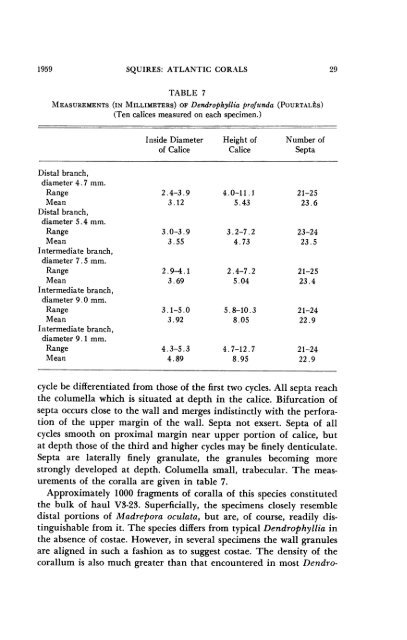MXieuicanJAuscum - American Museum of Natural History
MXieuicanJAuscum - American Museum of Natural History
MXieuicanJAuscum - American Museum of Natural History
You also want an ePaper? Increase the reach of your titles
YUMPU automatically turns print PDFs into web optimized ePapers that Google loves.
1959 SQUIRES: ATLANTIC CORALS<br />
99<br />
TABLE 7<br />
MEASUREMENTS (IN MILLIMETERS) OF Dendrophyllia pr<strong>of</strong>unda (POURTAL'S)<br />
(Ten calices measured on each specimen.)<br />
Inside Diameter Height <strong>of</strong> Number <strong>of</strong><br />
<strong>of</strong> Calice Calice Septa<br />
Distal branch,<br />
diameter 4.7 mm.<br />
Range 2.4-3.9 4.0-11.1 21-25<br />
Mean 3.12 5.43 23.6<br />
Distal branch,<br />
diameter 5.4 mm.<br />
Range 3.0-3.9 3.2-7.2 23-24<br />
Mean 3.55 4.73 23.5<br />
Intermediate branch,<br />
diameter 7. 5 mm.<br />
Range 2.9-4.1 2.4-7.2 21-25<br />
Mean 3.69 5.04 23.4<br />
Intermediate branch,<br />
diameter 9.0 mm.<br />
Range 3.1-5.0 5.8-10.3 21-24<br />
Mean 3.92 8.05 22.9<br />
Intermediate branch,<br />
diameter 9.1 mm.<br />
Range 4.3-5.3 4.7-12.7 21-24<br />
Mean 4.89 8.95 22.9<br />
cycle be differentiated from those <strong>of</strong> the first two cycles. All septa reach<br />
the columella which is situated at depth in the calice. Bifurcation <strong>of</strong><br />
septa occurs close to the wall and merges indistinctly with the perforation<br />
<strong>of</strong> the upper margin <strong>of</strong> the wall. Septa not exsert. Septa <strong>of</strong> all<br />
cycles smooth on proximal margin near upper portion <strong>of</strong> calice, but<br />
at depth those <strong>of</strong> the third and higher cycles may be finely denticulate.<br />
Septa are laterally finely granulate, the granules becoming more<br />
strongly developed at depth. Columella small, trabecular. The measurements<br />
<strong>of</strong> the coralla are given in table 7.<br />
Approximately 1000 fragments <strong>of</strong> coralla <strong>of</strong> this species constituted<br />
the bulk <strong>of</strong> haul V3-23. Superficially, the specimens closely resemble<br />
distal portions <strong>of</strong> Madrepora oculata, but are, <strong>of</strong> course, readily distinguishable<br />
from it. The species differs from typical Dendrophyllia in<br />
the absence <strong>of</strong> costae. However, in several specimens the wall granules<br />
are aligned in such a fashion as to suggest costae. The density <strong>of</strong> the<br />
corallum is also much greater than that encountered in most Dendro-
















